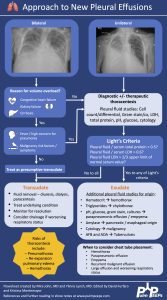
 PulmPEEPs
PulmPEEPs 104. Pulm PEEPs on Core IM – Pleural Effusions
21 snips
Jul 9, 2025 Chris Kapp, an interventional pulmonologist at Northwestern, shares invaluable insights on managing pleural effusions. He discusses the importance of thoracentesis and pleural fluid analysis, emphasizing accurate diagnosis with the LIGHTS criteria. Kapp clarifies the distinctions between transudative and exudative effusions and explains the role of pleural pH and cell counts in clinical assessment. He also delves into diagnostic challenges like eosinophilic effusions and the significance of adenosine deaminase in identifying tuberculosis pleuritis.
AI Snips
Chapters
Transcript
Episode notes
Resident Ultrasound Diagnostic Anecdote
- A resident mistook a lung cancer for a pleural effusion on chest X-ray until using ultrasound clarified the diagnosis.
- Ultrasound helped avoid an unnecessary thoracentesis by revealing a solid tumor rather than fluid.
When To Perform Thoracentesis
- Perform thoracentesis on new unilateral effusions safely and on bilateral effusions not improving with therapy.
- Seek thoracentesis with red flags like fever, weight loss, pleuritic pain, or hemoptysis for diagnostic clarity.
Multiple Etiologies in Effusions
- Up to 30% of pleural effusions can have multiple causes simultaneously.
- This highlights the importance of not anchoring on a single diagnosis when interpreting pleural fluid studies.

